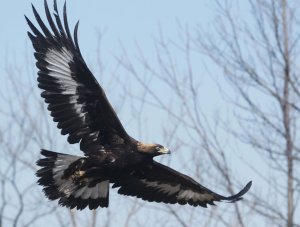Golden eagles would funnel through a turbine killing zone in Prince Edward County
 The south shore of Prince Edward County (PEC), where two industrial wind power generation projects are proposed (White Pines/wpd Canada and Ostrander Point/Gilead Power), is a main migration path for the at-risk Golden Eagle. This is clear from both government information on the birds, and is confirmed in the wind power developer’s own Species At Risk report; the wpd report was obtained by community group the County Coalition for Safe Appropriate Green Energy, or CCSAGE, through a Freedom of Information request.
The south shore of Prince Edward County (PEC), where two industrial wind power generation projects are proposed (White Pines/wpd Canada and Ostrander Point/Gilead Power), is a main migration path for the at-risk Golden Eagle. This is clear from both government information on the birds, and is confirmed in the wind power developer’s own Species At Risk report; the wpd report was obtained by community group the County Coalition for Safe Appropriate Green Energy, or CCSAGE, through a Freedom of Information request.
The wpd surveys reported an average of four Golden Eagles per day on each of the three survey days in November—and, according to the surveys, most were flying at the wind turbine blade height. As a result, there could be at least as many as 120 Golden Eagles migrating through the area in the month of November alone, all flying at the dangerous blade level. It is presumed the birds would return in spring via the same pathway.
According to the Ontario Ministry of Natural Resources or MNR website, only six pairs of Golden Eagle nest in Ontario, but more than 200 have been observed in southern Ontario, probably migrating to nest in northern Ontario and Quebec. From the information in the Species at Risk Report and on the MNR website, it appears that most, if not all, of the Eastern North American population of Golden Eagles will pass through a killing zone of wind turbines, if these are permitted to be constructed on the south shore of PEC.
These facts were not revealed to the public during the comment period for either wind power project, and have only come to light through the diligence of the citizens of Prince Edward County. That the government agency responsible for protecting Species at Risk and Endangered Species Acts would fail to act on this danger to wildlife is alarming.
Here are the facts:
- CCSAGE is not aware of any official reports highlighting the vulnerability and potential concern for raptors, and specifically the Golden Eagle, within or in official review of the documents/surveys supporting the Ostrander Point or White Pines wind projects.
- There do not appear to have been comprehensive raptor/Golden Eagle studies supporting the Ostrander Point project. A letter regarding Ostrander Point from Denise Fell of MOE to Erin Cotnam of MNR dated Feb 24 2010, notes “Stantec’s surveys of Ostrander likely do not provide a reliable index of Golden Eagle movement over the site during the fall migration period.” And “fall raptor surveys were not continued late enough (i.e., only to mid-October) to adequately survey Golden Eagle.” Why were adequate surveys not required, when the Golden Eagle and its habitat are protected under Ontario’s Endangered Species Act and have been designated as a Specially Protected Bird under the Ontario Fish and Wildlife Conservation Act?
- We recently discovered that MNR has clearly known about this area being a concentration point for the Golden Eagles – it is described in their website — see here and here . Also, the above mentioned letter from MOE states: “An observation credited to Phil Taylor of 1,100 raptors at Prince Edward Point Oct 29 2009, including 60 Golden Eagles and 25 Bald Eagles (BR Sec. 3.7, p. 3.9, para 6). These numbers are confirmed by David Okine, director of Prince Edward Point Bird Observatory.” Note these were recorded on one day. Holiday Beach [Essex County] is known to have the highest raptor counts in Ontario, and recorded 93 Golden Eagles in the whole of the migrating period. Between Ostrander/Gilead and wpd turbine projects, this large population of Golden Eagles is at risk.
- The wpd Species at Risk Report was not made available to the public during the formal review period. The first working day after the posted deadline for comment, it was released through the FOI Act. Why was the FOI report not released sooner?
- Why were the two projects considered complete and acceptable by MNR and MOE, after the area had been identified as a main migration route?
- Ontario and Canada have obligations under the Migratory Birds Convention Act to protect migratory species. These and other species identified in this report – including the migrating peregrine falcons, are endangered.
- There could eventually be hundreds of Industrial Wind Turbines in the 50 km of sensitive shoreline from PEC, through Bath/Amherst Island to Wolfe Island, if the Ontario government allows and approves these power projects. Why is the cumulative impact of these on the Golden Eagle and other endangered species not even considered?
- Environment Canada’s guidance document (Wind Turbines and Birds V. 8.2, p.21, 2007) lists 11 criteria of a site where turbines should not be sited – all are met by the south shore of PEC, yet turbines are considered approvable in the area.
- The passage of a large percentage of the Golden Eagles in eastern North America through a killing zone as this will become if wind turbines are permitted, will likely imperil this species.
These findings call into question the credibility of the science-based review that MNR and MOE perform, and whether approvals are political rather than science driven.
Anne Dumbrille
CCSAGE Naturally Green
Posted on July 6, 2014, in Advocacy / politics / legal, Natural environment, Ostrander Point, White Pines, Wind turbines. Bookmark the permalink. Leave a comment.
Leave a comment
Comments 0